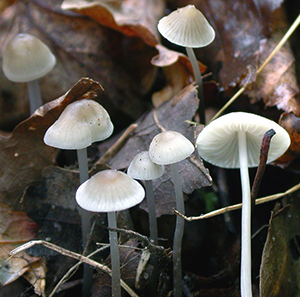Solitary or two or three together, rarely
more numerous. Growing on small pieces of bark or wood on
the ground, or on more or less buried twigs of deciduous
trees (mainly Quercus, but also other trees). Summer to late autumn. Common in the atlantic-nemoral-continental zones and apparently extended into the boreal zone. Widely distributed and very common in south Norway, but recorded all over the country.
 |
Pileus
6-22 mm across, conical to campanulate, flattening
with age, translucent-striate, sulcate, glabrous,
somewhat lubricous when wet, becoming shiny when dry,
grey-brown to pale grey, darker at the centre, paler
to almost white at the margin. Lamellae
14-23 reaching the stipe, ascending, narrowly adnate
to almost free, smooth but becoming veined to heavily
ribbed with age, dorsally intervenose, white to whitish,
sometimes more brownish, the edge concolorous to white.
Stipe 30-80 x 1-2 mm,
hollow, elastic-firm or even tenacious when wet, cartilaginous-brittle
when dry, equal to somewhat widening below, terete,
straight to curved, pruinose above, glabrous farther
down, lubricous to almost viscid when wet, shiny when
dry, pale grey-brown, usually with a whitish apex,
sometimes with reddish brown spots below, the base
sometimes rooting, densely covered with long, coarse,
flexuous, whitish fibrils. Odour
indistinctive, also reported as slightly fruity. Tast mostly noted as mild. |
| |
Basidia 28-42 x 9-11.5 µm, clavate,
4-spored, with sterigmata up to10 µm long. Spores
9.7-12.2 x 5.5-7.5 µm, Q 1.6-2.1, Qav 1.7-1.8, pip-shaped, smooth, amyloid. Cheilocystidia
15-40(-50) x 5-15 µm, forming a sterile band, clavate,
fusiform. lageniform or more irregularly shaped, apically
passing into a simple or furcate neck or more often with
simple to branched, straight to curved or flexuous, coarse
to very coarse excrescences up to 25x2-3.5 µm, in rare cases with no neck
or excrescences at all. Pleurocystidia
absent. Hyphae of the pileipellis
2.5-5 µm wide, covered with scattered to crowded, simple to much branched
excrescences 2-20 x 1 µm which tend to become somewhat gelatinized and
form very dense masses. Hyphae of the cortical
layer of the stipe 2.5-4.5 µm wide, smooth or occasionally
sparsely covered with short, cylindrical excrescences,
more or less embedded in gelatinous matter, the terminal
cells generally smooth but occasionally diverticulate
and much inflated. Clamp connections absent or with some abortive clamps (very rarely with abundant clamps).
Microphoto of cheilocystidia.
Mycena vitilis is quite variable
but it is seldom difficult to identify. It has no
striking character in the field, however, except for the
slippery, lubricous and elastic-firm stipe, which tends
to be very shiny when dry. The variously shaped cheilocystidia
are of good use for identification as well as the densely
diverticulate hyphae of the pileipellis and the smooth and
gelatinized hyphae of the stipe cortex. An important character
is that this species generally lacks clamps. Robich (2003) reported that the Italian material of M. vitilis
always possesses clamps but in my material from Norway clamps
nearly always are absent, or there are only some very few abortive clamps. This observation corresponds with Maas
Geesteranus (1992: 310). Recently, however, I have also seen M. vitilis with abundant clamp connections.
Large specimens of M. vitilis can sometimes resemble specimens of M. polygramma. They can be told apart as follows:
|
Mycena polygramma |
Mycena vitilis |
Lamellae |
> 23 |
< 23 |
Hyphae of the stipitipellis |
Not gelatinized |
gelatinized |
Spores Q average |
1.3-1.4 |
1.7-1.8 |
Clamps |
Abundant |
Generally absent |
|